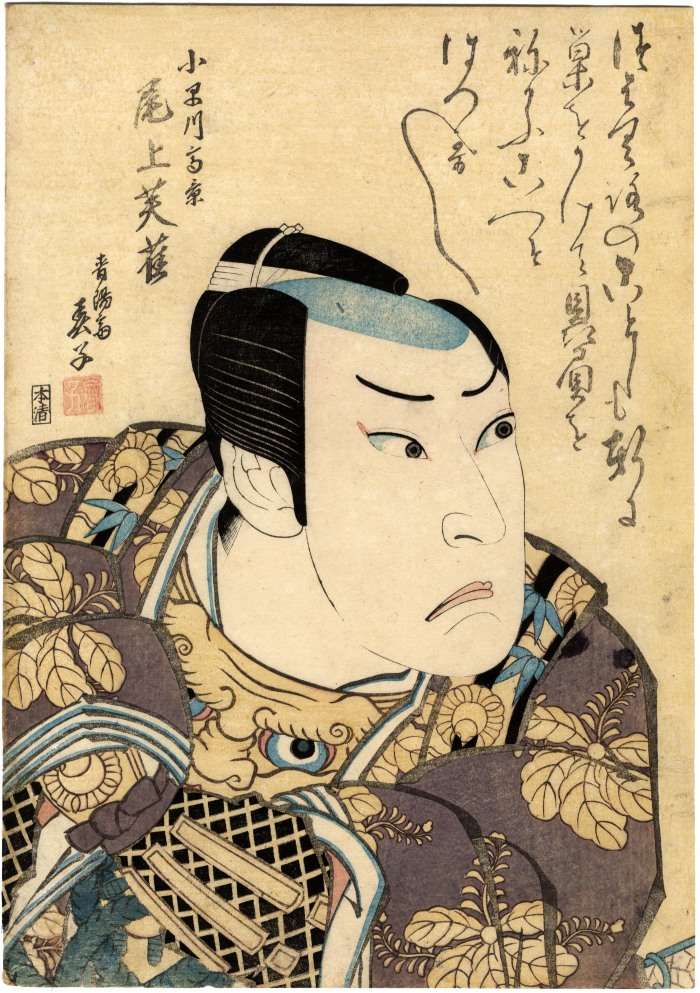Seiyōsai Shunshi (青陽齋春子) (artist )
Onoe Fujaku III (尾上芙雀) as Kobayakawa Takakage (小早川隆景)
ca 1826
10.4 in x 14.75 in (Overall dimensions) Japanese woodblock print
Signed: Shun'yosai Shunshi (春陽斎春子)
Publisher: Honya Seishichi (本清)
(Marks 123 - seal 25-527)
Metropolitan Museum of Art - the gift of Mikki and Sebastian Izzard John T. Carpenter, the Mary Griggs Burke Curator of Japanese Art at the Metropolitan Museum of Art, said in a video lecture, from November 4, 2022, 'A Poetics of Inscribed Kabuki Actor Portraits', said of this print by Shunshi: "...one of my favorite Osaka prints ever made..." Carpenter continued: "We are sure he studied under Hokushu, and all of his known works are actor portraits. But we suspect that he was not a professional artist, but rather a fan of kabuki who created these works as an avocation."
****
The curatorial files at the Met say: "This dramatic bust portrait of Onoe Fujaku III (1793–1831) captures the Osaka-based actor as a samurai garbed in a brilliant purple surcoat with paulownia crests, covering armor that has a breastplate in the form of a demon mask with piercing eyes. Fujaku is shown in a role based on a real-life daimyo Kobayakawa Takakage (1533–1597), who commanded troops for the Mori clan, into which he was born and belonged to before being adopted into the Kobayakawa clan. He helped both clans expand their territory in western Honshū through brilliant military campaigns, and eventually was able to exert even more power after becoming an ally of the great warlord Toyotomi Hideyoshi. Theater fans enjoyed the clever and playful ways in which Kabuki playwrights rewrote history."
"Though the role is named on the print, we have yet to find records of play represented."
"Though unsigned, the poem—a 31 syllable kyōka (witty poem)—is assuredly by the actor himself. The actor likens himself to a swallow returning home to build a nest in the early summer; according to Japanese folklore, swallows are said to sing greetings (tsubame no aisatsu) when they migrate from and back to the north. Perhaps the actor is suggesting that for this season he is returning to one of his former homes at one of the small theaters (hama shibai) in Osaka where he established himself as an actor, rather than the larger Ōnishi no Shibai, where he was regularly performing in his final years—that is, until it was destroyed by fire in the second month of 1827. Or he might possibly be referring to a return trip from Nagoya, where he performed intermittently in the early 1820s (including during the third to sixth months of 1824). Future research might connect the print to a particular performance and more precise date. Fujaku’s posthumous Buddhist name (kaimyō) was Myōon’in 妙音院, which literally means “exquisite sound,” so we can assume he had a soft but elegant voice. The kyōka reads:"
つはくろの ことしも軒に 巣をかけて
贔屓をねかふ こへそはつかし
"Tsubakuro no
kotoshi mo noki ni
su o kakete
hiiki o negau
koe zo hazukashi
Like a barn swallow,
again this year, building
its nests in the eaves,
we humbly lift our voices
to gather new admirers.
(Trans. John T. Carpenter)"
****
The historical Kobayakawa Takakage (小早川隆景) lived from 1533 to 7/26/1597.
According to the Dictionnaire historique du Japon for 1987, #460, page 11:
"Homme de guerre de l'époque Azuchi-Momoyama. Troisème fils de Mōri Motonari 毛利元就. A douze ans, il hérite de la position de chef du clan Koboyakawa et l'année suivante il est placé comme otage auprès d'Ōuchi Yoshitaka 大内義隆. Il rentre chez lui trois ans après et, avec son frère ainé Kikkawa Motoharu 吉川元春, il agit pour le compte de son père. Après la mort de celui-ci (1571), il aide son neveu devenu le chef du clan Mōri, Terumoto 輝元, et on peut dire que c'est en grande partie grâce à Takage que le clan Mōri put à cette époque devenir si puissant, contrôlant presque toutes les provinces du Chūgoku 中国 et étendant ses forces jusqu'à Shikoku une partie de Kyūshū."
"Hostile au régime que cherche à mettre en place Oda Nobunaga 織田信長, Takakage est confronté à l'un des vassaux de Nobunaga, le futur Toyotomi Hideyoshi 豊臣秀吉. Leurs camps respectif se trouvent face à face au château de Takamatsu 高松城 dan le Bichū. Lors de pourparlers de paix qui succèdent aux événtements du Honnō-ji (Honnō-ji no hen 本能寺の変) (1582), Takakage est l'un des protagonistes des discussions. Par la suite, Takakage agit en concertation avec Hideyoshi et même agit pour lui. Il finit par devenir l'un des cinq ministres (Gotairō 五大老) de Hideyoshi."
"Takakage s'illustre dans les campagnes menées par ce dernier dans le Shikoku ainsi qu'a Kyūshū et il reçoit un fief au revenu de 350 000 koku 石 de riz dans l'Iyo puis par la suite il se voit confier la province de Chikuzen plus deux districts du Chikugo et deux autres dans le Hizen."
"C'est dans le Chikuzen que finalement Takakage s'installe àpres s'être fait fortifier sa demeure à Najima 名島 et il joue un rôle actif dans la répression contre la révolte dans le domaine de Sassa Narimasa 佐々成政 du Higo. A l'occasion de la compagne d'Odawara 小田原, Takakage est chargé de la garde du château de Kiyosu 清洲城 en Owari, puis il participe également à l'attaque contre les provinces du nord avant de se joindre aussi à l'armée qui part envahir la Corée. A cette occasion, il est avec Tachibana Muneshige 立花宗茂 l'un des grandes artisans de la victoire japonaise à la bataille de Hekiteikan 碧蹄館 (cor. Pyōkchegwan) contre les armées chinoises."
"Après son retour, il adopta le futur Hideaki 秀秋, l'un des fils adoptifs de Hideyoshi, et en 1595 il lui céda la direction des affaires de sa maison et se retira sur ses terres dan la province de Bingo."
Kyōto-Osaka prints (kamigata-e - 上方絵) (genre)
actor prints (yakusha-e - 役者絵) (genre)
Onoe Fujaku III (三代目尾上芙雀: from 1818 or 1819 to 1/1831) (actor)
